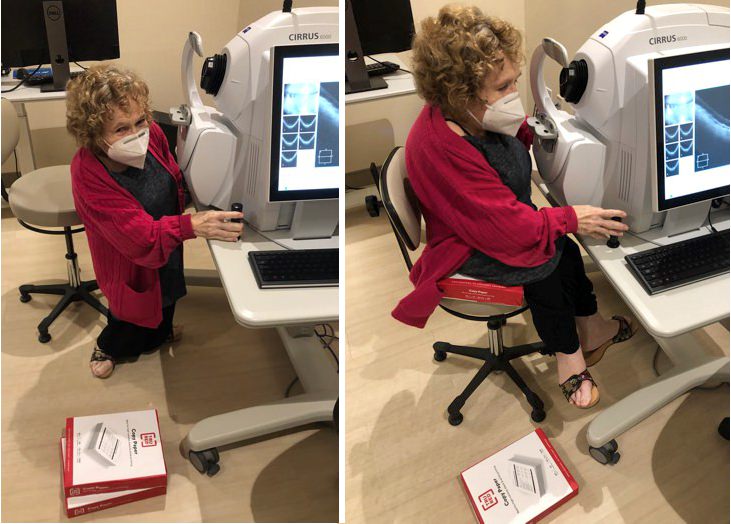
Knowing that glaucoma is a leading cause of blindness for three million Americans doesn’t make much of an impact if you think you don’t have it. But think again. You could have it and don’t know it. Glaucoma—the “Silent Thief of Sight”—has no symptoms in early stages. As a result, only 30 to 50 percent of cases are diagnosed.
The only way to know if you have glaucoma is to get a comprehensive dilated eye exam with visual field testing. People at higher risk should be tested every one to two years. This includes people (1) age 60 and over, especially Hispanics and Latinos, Asians, or
Want to subscribe to receive blog updates sign up today!
African Americans age 40 and over; and (2) those with a family history of glaucoma, elevated intraocular pressure, diabetes or high blood pressure (hypertension), myopia (nearsighted) or hyperopia (farsighted), eye injuries, or steroid use.
Despite having severe myopia and wearing glasses or contacts since my 20s, no eye doctor ever told me about being at risk for glaucoma. My great grandmother did go blind in her late 70s, but no diagnosis was made or shared with us grandchildren. As to family history, I do have an aunt with severe myopia being treated for glaucoma.
The first time glaucoma was mentioned to me was after my November 2021 vitrectomy surgery for a hole in the macula and retinal tear in my left eye. Notwithstanding surgical repairs, the optic nerve was irreparably damaged leaving me completely blind in that eye. In numerous post-operative visits, the surgeon repeatedly referenced my glaucoma as a possible explanation for the vision loss. Every time he did this, I told him I didn’t have a glaucoma diagnosis. After checking his notes, he agreed and apologized. However, I suspected he backed off because as a retina specialist it was outside his specialty to diagnose glaucoma. Yet I knew it was within his skill set to see telltale glaucoma indicators.
Consequently, I was highly motivated to do everything in my power to preserve vision in my one and only sighted eye. In addition to reliance on the Great Physician, I consulted with a glaucoma specialist for a diagnosis. At a specialty eye clinic, I had another immersive experience with inaccessible diagnostic equipment: Tonometry to measure eye pressure; Visual Field (Perimetry) to check peripheral vision; Fundus camera to observe the retina, optic disc, blood vessels, macula and fovea, and posterior pole; sonogram eye scan; Pachymetry to measure cornea thickness; and Gonioscopy to measure the drainage angle in my eye.
The conclusion? I am a glaucoma suspect! Even though a glaucoma diagnosis is uncertain, good follow-up care is the key to determining changes or “progression” over time. My vision, eye pressure, fluid drainage, and optic nerves will be checked at regular intervals. Meanwhile, I use topical eye drops to lower eye pressure. I will not be silent prey to this disease.
How about you? The Glaucoma Awareness month in January is a great time to check your vision status.
You may also want to read:
- Angela Muir Van Etten. “Tackling Inaccessible Medical Equipment, Part II.” Blog post. March 28, 2022. https://angelamuirvanetten.com/tackling-inaccessible-medical-equipment-part-ii/
- Angela Muir Van Etten. “Tackling Inaccessible Medical Equipment.” Blog post. April 19, 2021. https://angelamuirvanetten.com/tackling-inaccessible-medical-equipment/
- Angela Muir Van Etten. Dwarfs Don’t Live in Doll Houses; Pass Me your Shoes; and Always an Advocate. Dwarfism Memoir Trilogy. https://angelamuirvanetten.com/books/
Additional Resources:
- American Academy of Ophthalmology, https://www.aao.org
- American Glaucoma Society, https://www.americanglaucomasociety.net/home
- Bascom Palmer Eye Institute, https://umiamihealth.org/bascom-palmer-eye-institute.
- The Glaucoma Foundation, https://glaucomafoundation.org.
- National Eye Institute, https://www.nei.nih.gov.

2 replies on “GLAUCOMA: the “Silent Thief of Sight””
Angela, thanks for bringing attention to this very important and under diagnosed condition! My youngest sister has been on drops for over 10 years when borderline pressure increase was detected on an annual exam. Both of us have extreme myopia and some macular degeneration as a result, so we’re extra vigilant.
Thank you for sharing your story highlighting an oft neglected area of health.